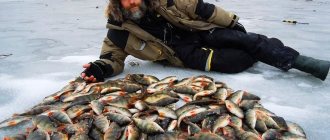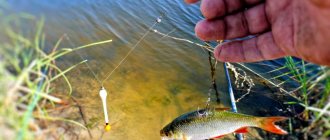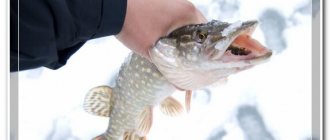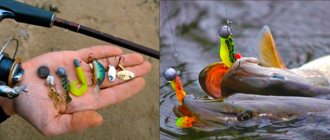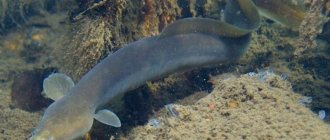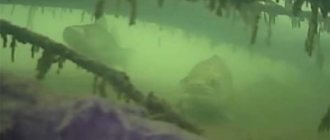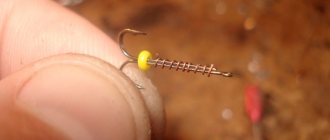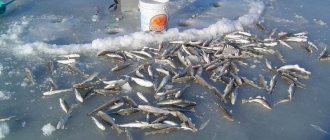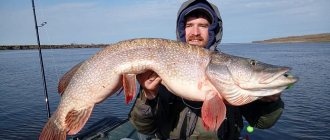- November 2, 2018
- Miscellaneous
- Andrey Raiter
Live bait fishing is one of the most effective ways of catching predatory fish. But this same method is also considered the most problematic, as it is associated with various nuances of preparing and storing bait. One of the key questions: how to quickly catch live bait in the summer? The warm period is the most attractive from the point of view of organizing such fishing, which is why the majority of fishermen who adhere to this tactic become active at this time.
What kind of fish do you use to make live bait?
Not all underwater fauna is suitable for creating live bait, even if we are talking about suitable sizes. Of course, every small fish and fry has its own predator, but the requirements include not only the taste preferences of the caught pike or perch. It is important to consider qualities such as survival and transportability of live bait. In the summer we catch fish that are also able to remain attractive to predators through their behavior, and this is also a question of the survivability of the bait.
As practice shows, the most valuable live bait is obtained from the following fish:
- Crucian carp. It is distinguished by its vitality and universal taste properties, which attract a wide variety of predators. A simple, universal and common bait in Russian conditions.
- Loach. A very rare type of live bait that not only retains the appearance of a living prey, but also shows an interesting trolling game. During the fishing process, you can use both standard gear and a donkey with wiring. As for the target fish, the loach is also universal, but it is more often used for pike.
- Rotan. Also an attractive prey for pike, as well as perch. However, it is summer time that is not the most favorable for rotan.
- Gudgeon. It appeals to a variety of predators, but its vitality is low.
- Perch. And this fish is not famous for its long survival time, but in favorable conditions it can be used to catch very large specimens of pike and pike perch.
- Top melter. Like crucian carp, it is able to withstand the harshest conditions, being an attractive prey for rotan, perch and pike. But it is very important to choose the right moment when the predator itself moves closer to the upper warm layers of reservoirs and lakes, where the apex swimmer lives.
- Rudd. It is a rare case when a fish not only lives in a river, but also performs well as bait in the same conditions. Another question: how to catch live bait from rudd in the summer so that it retains the desired characteristics even outside the water? And for this, at a minimum, you will need special compressors with autonomous power supply. There is no point in saving on such equipment, since together with roach, this fish can provide a good catch.
- Bleak. Both from a boat and from the shore, bleak can be caught at any time of the year using a regular fishing rod with wiring. Next, you can focus on perch and pike, which will willingly rise from the bottom to snack on pelagic fish.
- Ruff. If you have a clear goal of catching burbot, then you can safely cook ruff. But it should be applied as quickly as possible, since it does not last long in warm conditions.
☸ Ruff
As an object of fishing, this prickly fish is not of particular interest, except perhaps for preparing fish soup in nature. But as a live bait, the ruffe is very good, especially for fishing for burbot in the dark. It is not surprising, because both species are more active at night than during the day, and besides, they are closest neighbors in the reservoir. With the onset of darkness, the ruffe begins to move in search of larvae and other living creatures, and the burbot clearly registers fluctuations in the water and quickly finds it. In mid-autumn, when there are no longer so many fry, the ruffe becomes a desirable prey for pike, pike perch and bersh.
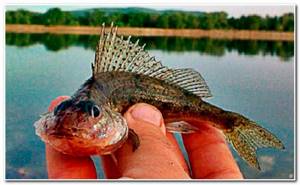
Asp also does not refuse this tasty fish. Sometimes there are moments when the predator does not show itself at all, as they say, neither a bite nor a splash. After unsuccessful experiments with several species of live bait, it begins to seem that there is no bait in the water at all. But once you put a small brush on the hook, everything falls into place. One can only guess why this inconvenient “thorn” attracts predatory fish. Most likely, the reason lies in the excellent taste of the ruff.
As a bait, the ruffe is suitable for fishing with a live bait rod, donka with appropriate equipment and mugs. But first he must be caught. During the day, it is best to do this with the help of a bait donkey, a feeder or a light picker, and at night, when the ruffes feed near the shore, a float rod equipped with a firefly becomes relevant. The bait in both cases is clay mixed with pieces of worms or food bloodworms. The same should be applied to the hooks. Besides clay, of course!
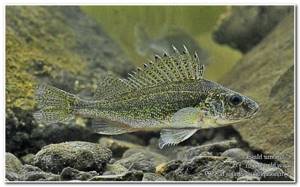
Where and when to fish? It is believed that in the late afternoon this fish leaves the depths and enters the coastal shallows, but it is extremely difficult to guess the locations of such exits. The most annoying thing is that the ruffs, which have been annoying throughout the summer, suddenly disappear somewhere in the fall. When you don’t need them, you don’t have time to take them off the hook, and when the need arises to catch a dozen live bait, the task turns out to be almost impossible. Therefore, persistent fishermen who, after much effort, manage to discover points visited by schools of ruff, do not tell anyone about them.
Storing “prickly bait fish” does not require any special tricks. A capacity of fifty liters, water from a reservoir and a suitable temperature (up to 10 degrees) - these are, in fact, all the components of long-term storage.
Basic methods of catching live bait
There are several popular methods of catching live bait, each of which has its own technical and design features. The choice of a specific method should be based on the species of the target fish and the fishing location. So, how to catch live bait in the summer?
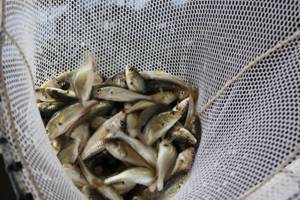
The most common ways to solve this problem are described below:
- Using a fishing rod with a float from the shore. This method is used to catch small crucian carp, rotan, gudgeon, roach and perch. Experienced fishermen advise catching live bait in the same body of water where you plan to hunt predators. In reservoir conditions, you can use donka, screening out what you catch based on size and appearance.
- On a fishing rod with a float from a boat. The best option for searching for live bait in river bays, overgrown creeks and where it is impossible to reach from the shore. The target objects in this case will be rudd and roach. Harvesting can be done both in summer and spring.
- Mesh. An effective approach to catching live bait in the summer on river shallows and in ponds. A regular fishing net with bread-based bait is used. A variety of little things can fall into such a trap, so the method is cheap and universal.
- A spider trap. Also the best option if you plan to use improvised methods. How to catch live bait in the summer using a spider? In essence, this is the same grid, but more manageable. It is called a spider for the reason that its corners are connected by thin metal rods with the ability to slam shut. The structure is immersed to a certain depth with bait and pulled out with small fish. In this way you can catch both roach with crucian carp and bleak with top-melting fish.
Catching predatory fish with live bait
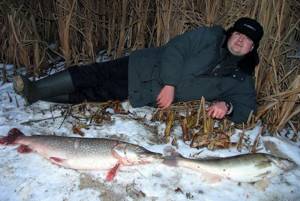
Despite some difficulties in preparing both the gear itself and the bait, fishing with live bait is a very exciting active hunt, which, as a rule, results in a solid catch. In addition to preparing gear for this type of fishing, it is necessary to have a supply of live bait - small live fish used as bait when catching predatory fish. You can, of course, go fishing without a supply of live bait, hoping to catch them directly at the main fishing site. However, this requires spending the precious hours of the early morning for a true amateur - the period of the most active feeding of predators, and it is not always possible to immediately catch the little things needed for bait. It is necessary to have at least a small supply of live bait (about a dozen) before leaving, and during the main fishing, replenish this supply with the help of a light float rod. The best live bait for almost all predators - pike, perch, pike perch, chub, burbot - is, of course, the gudgeon. Despite its dull, inconspicuous appearance, it is a tasty prey, holds on well to the tackle and is quite mobile for a long time if it is skillfully baited. However, its main drawback is its weak vitality. When transporting, gudgeons require cold, oxygen-rich water and quickly fall asleep when its volume is small, especially if it has warmed up to room (or higher) temperature. It has been established that when transporting minnows for 1-1.5 hours, each of them needs at least 0.25 liters of water with a temperature not exceeding 15° C.
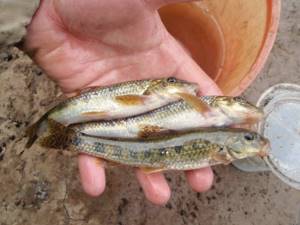
Minnows tolerate very cold water well, even if they are placed in it straight from warmer water. Therefore, immediately before leaving, it is useful to place pieces of ice in the water with them (this was discussed in the previous section). It is enough to simply catch minnows in advance in streams, small rivers, and ponds with an ordinary float rod using bloodworms or a piece of an ordinary worm (preferably a red subleaf). The gudgeon is usually caught by the lip, and it should be carefully removed from the hook and immediately placed in a cage immersed in water free from coastal grass. However, during hot days, taking minnows for live bait fishing is still risky, since it is not always possible to deliver them alive to the fishing site, and in this case it is advisable to use small crucian carp weighing 30-50 g as live bait.
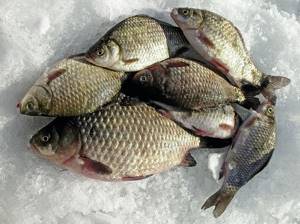
Crucian carp can live in warm water for a long time, easily tolerates long journeys, and in this sense it is an irreplaceable live bait, although predators are not always willing to take it. In recent years, crucian carp has spread in large numbers in all large and small ponds, both within cities and in most rural reservoirs, where there is constant water that does not freeze to the bottom in winter and does not dry out in summer, and coastal vegetation. And even if harmful waste flows into the pond, from which the rest of the fish die, the crucian carp manages to live and reproduce. Crucian carp are caught with a float rod with a thin - 0.15 mm - fishing line with a very light feather float and a hook No. 2.5 or 3.5 with bloodworms, worms, bread, semolina porridge. Just like the gudgeon, the crucian carp is easily removed from the hook undamaged and stored in a cage lowered into a reservoir. To attract small crucian carp to the fishing site, it is useful to periodically throw complementary foods into the reservoir in small portions - pearl barley porridge, bread crumbs, etc. In addition to fishing with float rods, gudgeons and crucian carp can be successfully caught with a small fish - a lift with a fine (preferably green) nylon net of the size 1×1 m. A bait is attached to the middle of the mesh - a crust of stale bread moistened with vegetable oil. The bread is placed in a small, loose mesh. It is useful to place a small stone in a net with bread so that the little wren lies on the bottom of the reservoir, and secure the bait itself with copper wire. Where there are a lot of crucian carp, it is usually easy to catch about three dozen (small) of them, removing the crucian carp 5-10 minutes after each dive. Small streams are most suitable for catching minnows. In this case, if the depth allows (0.5-0.8 m), the fisherman enters the water and, facing downstream, lowers the net on a pole along the stream and slightly moves the bottom layer with his feet. The turbidity that rises from the bottom spreads downstream, attracting minnows to the fishing site. As complementary food, it is useful to place a lump of clay soil, wrapped in a packaging net, mixed with food bloodworms (sold for aquarists) or finely chopped earthworms in the baby's net. It is more convenient for two people to catch minnows in this way, so that one does not have to leave the water, but, by bringing the minnow and minnows taken out of the water to the shore, give your friend the opportunity to select them, place them in the cage, clean the net and adjust the bait. When fishing with smallmouth bait, the caught live bait is not damaged by the hooks and, as a rule, remains alive longer. Other species of fish used as live bait - roach, perch, chub, bleak, as a rule, are distinguished by very poor viability outside the reservoir, do not tolerate transportation over long distances and therefore can be used as bait for predators only when directly catching these live bait on place of fishing. Loaches are also excellent live bait due to their increased mobility and activity on the hook, however, like minnows, they are less tenacious during long transportation. The use of verkhovkas or, as they are often popularly called, selyavkas, as live bait is also possible when fishing for perches, especially on clear autumn mornings, when perches chase fry in flocks. However, usually they have to be caught directly at the fishing site with a fine net, since the verkhovka cannot tolerate long-term transportation. In general, fry of almost all species of fish living in the reservoir where predators are caught can be used as live bait. Even ruffes are sometimes successfully used as live bait when catching pike perch (with the upper fin clipped), but this should be resorted to only when there are no live baits of the fish species listed above prepared in advance and brought to the fishing site. So, the fisherman arrived at the place of fishing with live bait, chose places to install gear, unpacked fishing rods and spinning rods and other necessary equipment. Aluminum stands with bells were stuck into the shore (they were already mentioned in previous sections), spinning rods with reels, sliding floats and weights, and steel leashes with hooks were assembled. Before starting fishing, it is imperative that the liner be collected and prepared, since a bite on live bait may immediately follow, and the brought live bait is placed in a mesh metal cage and immersed on a cord into the reservoir. Now it is necessary to attach the bait so that it does not jump off when casting and holds firmly on the hooks and at the same time floats alive quite freely and for a long time in the water, attracting a predator. There are many ways to attach live bait, and they are described in detail in various fishing manuals. However, the following methods should be considered the best. The double hook is removed from the end of the two-legged steel leash. The freed end of the leash, eye first, is threaded under the gill cover of the baitfish (do not damage the gills themselves!) and brought out through the mouth of the baitfish. The double hook is again inserted into the eye of the leash and the leash is moved back so that both hook tips are on the sides of the head and point down towards the tail. The second, triple hook, embedded in the ring of the leash at the junction of two knees, is stuck into the body of the live bait under the dorsal fin, trying not to seriously damage its body. With an extended vertical line, the live bait planted in this way will be in a horizontal, natural position for it, and the presence of two hinged elbows of the leash and a sufficiently high position of the load on the line will ensure its free swimming in the water. The second way to attach a live bait is without using a second treble hook at the junction of the leash knees. When attaching live bait using the first method - on 2 hooks - the hook when a predator bites should be done immediately after the float is immersed; the second method of attaching live bait is designed for the predator to grab the bait "by the throat", that is, when it has already swallowed the bait. Most predators - pike, perch, chub, burbot and others (except pike perch) - swallow live bait from the head, and therefore the double hook protruding from its mouth with stings directed towards the tail passes freely through the throat of the predator, and only after an energetic When hooking, the hook digs inside the body, reliably catching the prey.
When fishing for pike perch, you should use a different bait method, especially when fishing at night in the shallows, where it feeds heavily. Minnows are often used as live bait. In this case, a leash made of nylon vein with one double or single (large size) hook is used, which is pierced from the side of the baitfish’s mouth and clings to the lower lip. The barb of the hook should be sufficiently bent from its sting so that the bait does not jump off spontaneously. The pike perch, chasing small things, grabs the bait from the tail and swallows it immediately. A hook set in the manner described above does not encounter obstacles when the pike perch swallows live bait, and is caught when the fishing line is pulled back. Other predators, for example, pike, usually grab the live bait crosswise, squeeze their mouths and crush the live bait, and only then swallow it, turning it head first. When fishing for perch, very small live bait, including top bait, can be attached with one double or single hook (No. 5-7) directly under the dorsal fin. The bait by the lip is very unreliable, since the fry usually easily jumps off or, when casting, the hook tears off its lip. Naturally, when biting a fry planted in this way, hooking should be done immediately. You can use a soft vein leash when catching perches with a top and fry, since the perch usually does not have time to rub the vein line with its brush on the lips, but if small pikes hunt fry together with perches, such a vein will be almost instantly bitten by them, so it is better to put at least a single-track short (5-7 cm) steel leash. There are other ways to attach live bait, for example, by passing a leader under the skin of the fish and bringing the hook out through the gills and mouth (or sticking one tip of a treble hook directly into the body of the bait fish near the head). This method is described in the book of the famous fishing expert L.P. Sabaneev “Life and catching freshwater fish.” However, it is easy to damage the fish’s “lateral line,” a very important sensory organ. In addition, when casting gear with such a landing, the baitfish’s skin is easily damaged, and it is less mobile in the water (due to additional trauma) and falls asleep faster. Attaching a live bait by the tail with a single hook is also impractical, since it deprives it of the ability to naturally swim in the water, and when casting, it usually jumps off the hook. The main conditions for the correct and effective baiting of live bait are ensuring its free, natural movement in the water and long-term activity (in order to less frequently re-throw the tackle) and the correct position of the hooks on the live bait, so that when it is grabbed and swallowed by a predator, the hooks do not cause premature disturbance to the predator, and when hooked, they firmly stuck into his mouth. When attaching live bait, you must be careful: do not unnecessarily injure the fish, do not squeeze it too much in your hands when landing on the hooks. We must remember that live bait must actively move in the water, thereby attracting a predator that searches for prey not only with the help of vision, but also by the vibrations of the water produced by the moving baitfish.
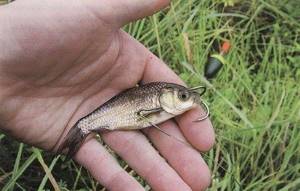
For the same purposes, when preparing the gear for casting, you should correctly select the depth at which the live bait will be located when fishing. Most predators - pike, burbot, pike perch, perch, if they do not hunt fry in flocks, look for their prey, moving close to the bottom, with the exception of asp, which hunts in the surface layer of the reservoir. But catching asp with live bait is hardly advisable, so the live bait should be close to the bottom of the reservoir. However, taking into account the unevenness of the bottom and the changing depth of the reservoir, it is advisable to place live bait at a distance of about half a meter from the bottom, and the behavioral characteristics of the fish species used in this case as live bait should also be taken into account. Gudgeon, crucian carp, and char, planted as live bait, will try to hide near the bottom in its unevenness and vegetation, huddling in a shelter and standing motionless, which is unlikely to attract the attention of a predator. Roaches, hybrids, and perches usually choose the middle layers of water, but still gravitate toward the bottom areas. Therefore, they do not have a pronounced desire to burrow at the bottom, and in most cases they tend to swim rather from spacious areas of the reservoir closer to the shore. Large specimens of fish of these species also lead a bottom-dwelling lifestyle, but in this case we are talking about small fish used as live bait. By setting a delay on the line of a spinning tackle with a sliding float or moving the float on a telescopic live bait fishing rod, you select the required depth of immersion of the live bait before casting. If, with good fresh bait, the float immediately becomes motionless, it means that the bait has buried itself in the bottom and the predator’s bite can only be accidental, and then only during periods of strong feeding. Live bait on gear thrown into a reservoir should actively move and not be covered by coastal or bottom vegetation. The position of the live bait is determined by the float, which, if the sinker is correctly selected in terms of volume and weight, reacts sensitively to the behavior of the live bait.
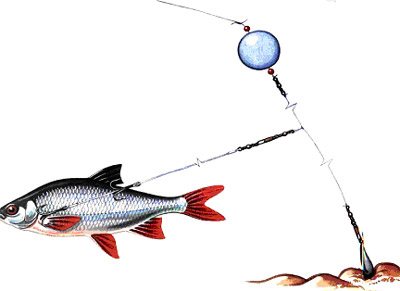
Fishing with live bait using spinning tackle with a sliding float is especially effective in reservoirs, lakes, ponds, and in quiet river bays. On rivers with fast currents, it is necessary to choose places with a reverse current (by the way, such places are usually loved by predators) and, having determined the casting range accordingly, force the float with a load and live bait to make large circular swims, falling alternately into the forward and reverse currents. If the current in the river is generally weak, you can use an additional weight at the end of the tackle to hold the live bait in one place, tying it on a separate long leash (0.5 m or more) at the location of the main sliding load, so that the live bait with the leash can swim in a limited space. Still, the best results when fishing with spinning tackle with a sliding float will be in reservoirs without a noticeable current. So, the live bait is baited, the correct depth of its immersion is selected by setting the delay, all that remains is to throw it into the reservoir. Amateur fishermen who are good at using a spinning rod when fishing with a spoon can quickly and successfully master casting the described gear with live bait. Those who have never used a spinning rod will have to master this method, described in numerous literature on spinning. At the same time, you should not strive to immediately make long casts, but you should learn to slow down the reel when casting with your finger in order to avoid the line running over and the formation of a “beard” on the reel. We consider it useful to recommend a few tips on casting a spinning rod with live bait to both beginners and already quite experienced amateur fishermen. Before casting, it is necessary to adjust the braking screw on the reel (on the Nevskaya this is especially convenient), so that under the weight of live bait and cargo, the reel rotates spontaneously with some light force (the ratcheting brake must be turned off). From the upper end of the spinning rod, the live bait should be at a distance of about half a meter or more, if coastal vegetation allows, which the live bait can touch when casting. Moving your hand with the spinning rod back, at the moment when the live bait and the load stretch the fishing line almost horizontally, make a smooth cast, accelerating the movement of the top of the spinning rod, and at the moment when the live bait appears in front of the angler against the backdrop of the reservoir, you need to remove your finger from the reel drum. In this case, the load with live bait will fly into the reservoir at an angle of 30-40° to the water surface. During the flight of live bait, it is necessary to slightly slow down the reel drum, preventing the line from running over. At the moment when the bait with the load touches the water, the finger is pressed against the drum of the reel, the rotation of which should instantly stop. The weight, sinking to the bottom with live bait, pulls the fishing line along with it until the delay installed on it above the float stops further diving. The float, having sunk to 70-80% of its height, will stand vertically on the surface of the water, holding the bait at a given depth. You should not make sudden movements when casting, as is practiced by spinners when fishing with a spinner - the so-called “whipping”. The baitfish can easily jump off when casting or will be severely injured by the hooks and will soon fall asleep. The cast is done. It is necessary to select the extra meters of fishing line with a reel and place the spinning rod handle in a duralumin stand so that the angle of the rod to the surface of the reservoir is about 70°. If there is tall grass near the stand, it is necessary to trim it so that it does not interfere with the rotation of the reel when biting and the operation of the alarm bell. Having bent the aluminum strip of the stand, attach a rubber ring of thread from a bell to its end, and its other end - with a rubber cap - is put on one of the handles of the reel, placing it in the upper position. In this case, the bell itself should hang on a thread, without touching the reel and stand. After turning the coil one turn to check, you need to make sure that it rotates freely and that the bell, changing its position in space, will ring without touching the stand, coil or grass. Having loaded one spinning tackle in this way, move on to the second and third if the angler intends to fish with several tackles at the same time. The distance between adjacent spinning gear should be such that live bait, moving in the water, cannot confuse the gear. When installing the next tackle, you need to be attentive to the ones already installed and monitor the position of the floats and reels, the bell signal, so as not to miss the bite, which often happens immediately after casting. So, the spinning gear is abandoned, the floats are on the pond, you can now choose a place on the shore from which all the floats and spinning reels are clearly visible, and relax.
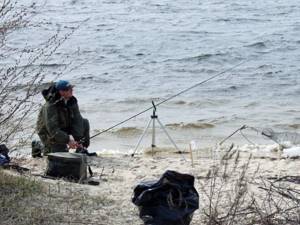
Usually, live bait thrown into a pond on gear immediately begins to move the float along the surface, trying to find shelter from the predator in the water. Moreover, its movements are to a certain extent constrained by the load of the fishing line and the resistance of the float. Hooks in the body and mouth interfere with and disturb the baitfish, so that after a while its active actions decrease. A float in a semi-submerged vertical position stops or floats quietly under the influence of wind or weak current. This is the normal state of the live bait rig and there is no need to re-throw it. But if the float from a vertical position becomes motionless in an inclined position or completely lies on the water, this means that the baitfish is buried in the bottom silt or vegetation and therefore is unlikely to be noticed by a predator. This means that the “bottom” was set incorrectly, that is, the immersion depth of the live bait was too deep. In this case, it is advisable to wind the fishing line with a reel, reduce the depth of its immersion by moving the line delay by 30-50 cm, and repeat the cast again. However, you should not re-cast often, since the live bait is injured from the hooks and from hitting the surface of the water and usually after 3-4 casts it becomes inactive and even falls asleep completely. Live bait attracts a predator, even when it is at a great distance from it, its movements are transmitted through the water and are perceived by the lateral line of the predator (a very important sensory organ for fish), which will immediately head towards its prey. The bait fish, in turn, with the help of its lateral line, will sense the approach of a predator and will strive to get away from it, actively moving in the water column, trying to hide on the bottom or in bottom vegetation. This behavior of live bait is clearly visible in the float, which, previously calmly floating in the water, suddenly begins to move quickly and randomly, dives slightly for a short time, and floats up again. At this moment, the fisherman needs to be very careful, approach the spinning rod carefully and be ready to hook. The movements of the float become more and more restless, faster, and then the float dives sharply, silently and, without showing itself, begins to pull out the slack in the fishing line. This is a sure sign that the bait has been grabbed by a predator. If the live bait was planted on 2 hooks, including one under the dorsal fin, or one also under the dorsal fin, it is necessary to immediately hook it before the predator, holding the live bait in its mouth, gets stuck on the stings of the hooks. To hook, having dropped the rubber cap from the reel and taken the spinning rod out of the stand, select the slack line with the reel and at the moment when the hand feels that all the line has been selected, make a fairly sharp and strong jerk with the rod. The mouth of predators, such as pike, is quite hard, and for a reliable hook, it is sometimes useful to repeat the hook. Usually after this the predator stops and then quickly and strongly pulls the line into the water, bending the tip of the rod. The fight with a strong opponent begins, in which the fisherman’s skill, experience and endurance must be fully demonstrated. By the force of resistance, you can determine the approximate size of the predator, but before it appears on the surface, you must be careful in your actions to catch prey. If it is a large perch, it should be remembered that perches have weak lips and the hook can be torn out, sometimes along with the lip, by sudden or too much effort by the angler. If a pike took it, then perhaps it was caught by the edge of its mouth, sometimes by a thin film in the edge of the lower jaw. In both cases, you should refrain from sudden jerks and excessive efforts, increasing the survival time until the predator is completely tired. Large specimens of pike - 3 kg or more - are usually reluctant to rise to the surface, and you have to spend more time when fishing and gain patience, and this is sometimes not enough, especially for young, less experienced fishermen, until finally the large, slab-like body of the pike appears near the surface . Smaller specimens of pike usually behave more actively when hooked, with jerks and sharp turns forcing the angler to give up the line and then reel it in again. Often pikes, wanting to free themselves from hooks and the fishing line pulling them, make a so-called “candle”, jumping out of the water with their mouths wide open. Moreover, if the line remains taut—the angler did not have time to slacken the line by tilting the rod—the pike sometimes manages to free itself from the hooks.
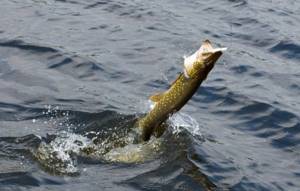
Often a predator, having been hooked, seeks to go into hiding - into bushes, into snags, and this must be prevented, since in most cases, having entangled the fishing line in snags, it becomes inaccessible to the fisherman. The matter ends with the fact that you have to break off the fishing line, losing the prey, the load, the leash with hooks, and sometimes the float. When fishing for a predator, different situations arise, and it is impossible to give comprehensive recipes to the fisherman for successfully completing the process in all cases. And if, despite all the measures taken, the catch is still lost, there is no need to be very upset - after all, it is not the last, and the process itself - fishing, even if it ended with the loss of fish, will leave an unforgettable, exciting impression in the fisherman’s memory.
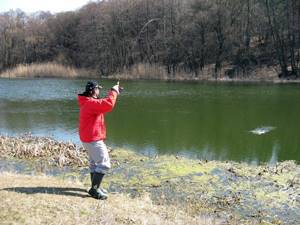
So, by skillful fishing, the predator is finally tired and allows itself to be brought to the shore. The collected and prepared eyeliner is nearby on the shore. Before finally pulling the prey to the shore, it is necessary to lower the liner net into the water in advance so that 30-40 cm remains between it and the surface of the water. With the rod extended along the line, reel in the last meters of the line, while simultaneously maneuvering the end of the rod so that the predator is above the net, while As soon as his head is above the middle of the net, the liner is sharply raised up. At the same time, the predator instantly dives down and falls into the mesh of the net. Without lifting the net high, the liner is almost dragged out of the water and, together with the spinning rod, is carried further ashore, to a flat, comfortable place. Here, having calmly released the hooks caught in the mesh, they remove the prey from the liner and free it from the hooks. For this purpose, you can use a gaper and a fork, sold in fishing supply stores.
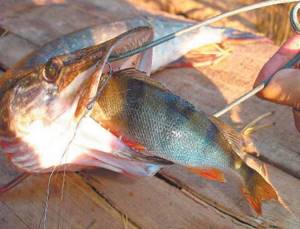
If it is difficult to remove the hooks, cut off the leash from the fishing line and leave it in the mouth to be removed at home when cutting up fallen fish. Inept removal of hooks from the mouth of a pike, firstly, can lead to severe injuries to the hands from its teeth, which usually do not heal for a long time, and, in addition, will lead to premature falling asleep of the prey, which in hot weather will lead to its damage. The caught prey is placed in a spacious metal cage, and if it is a pike, it is placed on a kukan and, having securely fastened the string to a peg driven into the shore, it is lowered into the reservoir.

The spinning tackle is equipped with a new leash, bait is attached and thrown back into the reservoir closer to the place where the previous bite was. When catching predators with live bait on 2-3 spinning tackles, especially if they are placed far from each other or if coastal bushes and trees, blocking the surface of the reservoir, interfere with simultaneous observation of all floats, it is advisable to place live bait on one double hook, passing the leash under the gill cover with withdrawal through the mouth. This will enable the fisherman to avoid the predator leaving after the bite, if the hook is not made immediately. The fact is that most predators, including the most likely prey in our reservoirs - pike, at the first throw grab the bait fish across and, clenching their jaws, catch it, swimming several meters (sometimes up to 10-15 m). Then, stopping, the pike turns the bait over in its mouth and swallows it half-dead from the head. At the moment of the first bite, there are no hooks in the pike’s mouth, and a freely placed reel (without a ratchet brake) releases the line without noticeable resistance as the pike swims with live bait. The pike, having swam a certain distance with live bait in its mouth and unwinding part of the fishing line from the reel, causes the latter to rotate and the signal bell to ring. The float is usually hidden in the water or, tilted, moves vigorously to the side. The fisherman's sensitive ear will immediately hear the bell signal, even if the movement of the float and the rotation of the reel drum were not noticed. Having grabbed the liner, the fisherman, without hesitation, heads to the spinning tackle where the bite occurred and prepares to hook. If the rotation of the reel drum has stopped in full view of the fisherman, you should wait for 5-10 seconds (usually after this period of time the reel drum begins to rotate again and the fishing line quickly and confidently goes into the water) and, taking out the resulting slack in the fishing line, make a sharp, strong hook with a spinning rod. As a rule, by this moment the baitfish has already been swallowed by the predator, and when hooked, the stings of the double hook are firmly embedded inside the predator’s body. Feeling the pain and resistance of the fishing line pulling it, the pike makes a sharp jerk (sometimes tearing the reel handle out of its fingers). Fishing for prey begins using the method described above. At the same time, gatherings of the predator are very rare, and soon the prey ends up in the eyeliner net. It also happens that a fisherman, while busy with other gear or catching live bait with a float rod, will not notice the movement of the float and the rotation of the reel and will not hear the bell signal. In this case, the pike, having swallowed the bait, unwinds a large amount of fishing line, sometimes up to 40-50 m. Having discovered this position of the gear, the fisherman must, without hesitation, use a reel to pick up all the slack in the fishing line and make a wide, strong hook. It happens that, having unwinded a large amount of fishing line, a predator heads for shelter - into snags - and there it entangles the fishing line tightly. Therefore, after an energetic wide hook, you need to wait a second or two and, if the line is pulled forcefully into the water again, immediately begin reeling it back, without fear of breaking - with a significant length, the line has great shock-absorbing ability and dampens the jerks of the predator. If, after hooking, you don’t feel the line pulling back, then this is a sure sign that a predator has led it into snags, which almost always leads to the loss of prey and forced breakage of the line. However, in this case, do not rush to break the line, but try to force the prey to come out of its hiding place with pushes and light tugs. As soon as this is felt along the line, immediately begin reeling, preventing the predator from going back into the snags. If time and circumstances permit, for example, when fishing with several gears, the gear can be left in this position, hoping that the predator will come out of the snags on its own, which sometimes happens. It is imperative to put the alarm bell on the reel again and carefully monitor this gear. At the first sound of a bell or the appearance of a float on the surface of the water, if it was previously submerged, you must immediately hook and then land the prey. Sometimes a pike or perch, having swallowed the bait and swam with it to a long distance, unwinds the entire supply of fishing line on the reel, and then, in most cases, stopping and feeling the resistance of the fishing line, throws out the bait, even swallowed, and leaves freely. An angler who misses a bite finds the fishing line completely unwound from the reel and, to his chagrin, chooses it with an empty hook or with live bait wounded by the teeth of a predator. It happens that after unwinding the entire supply of fishing line from the reel, the pike is still unable to free itself from the hooks caught inside it (although it throws out the bait itself) and, trying to get away from the fishing line holding it, gets hooked itself. Making attempts to escape, the pike forces the top of the spinning rod to bend and even, with considerable weight, swinging it, can pull it out of the stand, depriving the angler not only of prey, but also of the entire tackle. It is necessary to carefully monitor the condition of the supplied gear and respond to every bite in a timely manner. The method described here of landing live bait on one double hook under the gill cover with output through the mouth, designed for a predator’s “gulp” grip, is less sporting and interesting from the position of a true amateur fisherman and can only be recommended when fishing with several gears placed far away. from friend. The best, most interesting way for active fishing with live bait and, I must say, the most effective method in terms of catch, is to attach live bait to 2 hooks, including one tee under the dorsal fin. You can also use a bait on one (double or triple) hook under the dorsal fin.
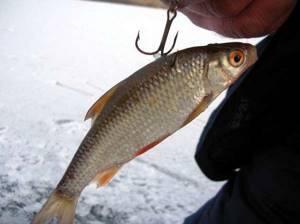
It is advisable to do this with very small live bait or if weak fish species are used - bleak, chub and others. However, you should be very careful when casting gear with live bait planted in this way, since with sudden movements it easily jumps off the hook, and when biting, you must hook it immediately. It should be remembered that bleaks, usually gathering in schools, swim in the middle and surface layers of water, in places where the direct and reverse flow of the river forms small whirlpools. Therefore, when placing bleak as live bait, choose its immersion depth equal to approximately 60% of the depth of the reservoir in a given place. The bleak, trying to rise to the upper layers of the water, will be constantly on the move, and its active behavior on the hook attracts a predator. The same should be kept in mind when baiting verkhovkas as live bait. And when using bottom fish - crucian carp, ruffe - setting the immersion depth of the live bait should prevent it from reaching the bottom of the reservoir, where, hiding behind a stone, snag or vegetation, the crucian carp hides and becomes unnoticeable to predators. The method of attaching small live bait (as well as bleak and top bait) with one hook under the dorsal fin is mainly recommended when fishing for live bait with a telescopic float rod with a float attached to the fishing line and with a short casting range. For medium and especially large live bait, the most appropriate is a spinning live bait tackle with a large sliding float and a delay on the line, which allows you to make long casts and adjust the tackle to any given diving depth of the live bait. However, in late autumn, in the second half of October, even under favorable weather conditions, it is rarely possible to observe small fish playing on the surface of a reservoir, since almost all the fish are in the bottom layers of water and lead a less active lifestyle. But it is during this period that most cases of catching the largest pikes occur. It can be difficult to get live bait in the required quantities at this time. And yet, if you are sure that large pike are found in a given reservoir, you should try to hunt for them. During this period, the water, as a rule, becomes very transparent, the aquatic vegetation, dying, falls to the bottom, the baitfish, planted on the tackle, has nowhere to hide, and it becomes visible to predators both at great depths and at a considerable distance. For large specimens of pike during this period, larger live baits are most suitable, for example, roach weighing 100-150 g, caught here with bloodworms. The line on the spinning tackle should be stronger - with a diameter of 0.6-0.7 mm, hooks (double and triple) No. 7-8 - with a reliable two-legged metal leash and a large sliding float. The weight of the load is not particularly important here, since when casting the main weight is borne by large live bait, and incomplete immersion of a large float, on the contrary, will not allow the live bait to drown it completely. As for the predator itself, given its considerable weight and strength, some additional resistance of a large and not completely submerged float cannot interfere with the predator’s swift and powerful grip. At the same time, the reel on the spinning tackle begins to rotate sharply and at high speed, unwinding up to 20-25 m of fishing line in a few seconds, and the bell begins to ring desperately, signaling the fisherman about a bite from a large predator. For such fishing, it is necessary to place the tackle in deep places and away from the shore, and the fisherman himself, remembering the autumn transparency of the water, should not stand directly by the water, but watch the tackle from behind bushes, trees and other shelters. Of course, bites from large pikes are rare, but what an unforgettable, exciting impression the bite and landing of large prey makes for many years. Having stopped abruptly after hooking, a large pike in the first seconds does not even try to pull the fishing line towards itself. It is useful to make a second sharp short hook so that the hooks fit more securely into its hard, toothy mouth. And only after 3-5 seconds it will powerfully pull the fishing line deep into the reservoir, unwinding it from the reel of the reel, which is held with difficulty by the fisherman. The top of the spinning rod bends towards the water, the fishing line is pulled into a string, and the fisherman has to return it meter by meter. However, as soon as the tension of the fishing line weakens, it is necessary to begin rewinding, sometimes again releasing the gained meters to the pike. Still, even a large pike gets tired relatively quickly, and the hooks stuck in its mouth cause it pain,
How to catch live bait in the summer using a bottle?
Various types of traps for catching live bait are made from plastic bottles of different sizes, but in this case the most thorough and effective one will be considered. The work will require a regular 5-liter plastic bottle, which will only need to be slightly altered. The instructions for making a means for catching live bait of this type are as follows:
- The cap and neck of the bottle are removed.
- The part with the neck is turned over and placed with the reverse side in the niche of the bottle.
- Using an awl and thin wire, you need to sew the neck to the side edges of the cut container.
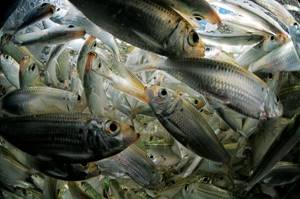
As you can see, the result is a fairly simple and affordable design. How does this method of catching live bait in the summer work? It should be used in shallow water, where there are small fish like roach or perch. The structure is buried in the ground under water to the level of the cut line. As bait, which is pre-placed at the bottom, you can use something odorous such as a slurry of bread, cake and sunflower. The attracted fish will fall to the bottom through the hole in the neck and remain there.
In the same way, you can use a 3-liter glass jar, providing a gauze pad instead of a lid in the passage part. A small slot of 3-4 cm is made in it, and the same bait is placed inside. At a good time, as the fishermen themselves claim, in this way you can lure up to a dozen fish in half an hour.
What should you know about catching whitebait?
Any body of water annually spoils local fishermen with bursts of changes in the population of a certain type of fish. This could be, for example, the activation of fry of sprat or sabrefish, which feed on predators such as pike perch, pike and perch. Actually, the target catch of the average fisherman in Russian conditions. But you can focus on large sizes only when catching crucian carp, bleak or gudgeon with fry. In any case, the main task is to correctly record the activity of the population and determine the target object of fishing.
How to catch fry in the summer for live bait? To begin with, it is worth considering that the mouth of fry is very small, so special lifts made of a wire metal frame and fine mesh are often used to prepare it. When harvesting on rivers, fishing with a lift is technically complicated. On small rivers you may not expect any results at all. In addition, the lift structures are quite cumbersome, and carrying them along with other equipment is extremely inconvenient. Therefore, the use of various types of traps with bait in the form of waste is increasingly practiced. Such devices will be discussed below.
Best time of day to catch a catch
After mid-August, the air temperature at night decreases slightly, and the water temperature decreases accordingly. A decrease in temperature affects the bite in a positive direction. At this time, the fish senses the approach of autumn, and then winter, and therefore tries to feed as much as possible. During this period, fish lead an active lifestyle and are in constant search of food.
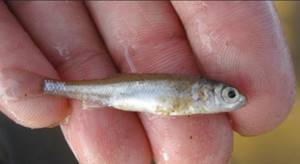
The best time for fishing is considered to be early morning, when the fish are most voracious. In the second half of the month, fishing for predatory fish is popular. The best gear is considered to be a spinning rod, lace and track. At this time, pike perch are the worst to catch, but catfish stop biting altogether. After the temperature drops in reservoirs, most of the algae die off and therefore it becomes increasingly difficult for predators to hunt for stronger fry.
Having chosen a place for fishing, you first need to determine the location of the predators. As a rule, this can be shallow water or, conversely, the deepest places, or the near coast or the middle of the reservoir. For example, catfish, pike, perch and other predators prefer to hide in underwater snags, holes and under steep banks, where the current is quietest and there are no whirlpools. The chub prefers places near bridges, dams and sunken beams.
How to catch fry for live bait in the summer?
If used correctly, a regular metal bucket can give good fishing results. The fact is that on rivers, fry often seek refuge under the coastline behind capes and in hollows. In such places you can fish with a bucket with holes made in the side walls with an ordinary nail. About a dozen holes are made on the outside through which water will pass. The structure is placed under the shore so that the bottom faces against the current or towards the depression. After a little time, the fry will begin to look for protection in the bucket. At this moment, you must react quickly by turning the bucket to a vertical position, blocking the exit.
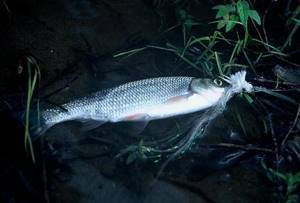
If we are talking about fishing on a pond or in fast-flowing conditions, then the trap described above changes slightly. How to catch fry for live bait in this case? It is better to initially make the container from a metal mesh, which will give the structure stability against the background of a fast flow. If you plan to place it in a hard-to-reach place, then it is better to provide a rope for pulling it out, having thought in advance about the correct configuration of the removal in the direction so as not to miss the fry. And also don’t forget about the bait. The same bread with flavorings will give results in 10-15 minutes.
How to catch pike with live bait?
In this case there are many features. Catching pike with live bait requires certain knowledge in this area. Today this method is not relevant. After all, spinners and twisters have almost completely eclipsed live bait. There are many of these devices. But don’t immediately forget live bait as bait. After all, it is he who is the real “parent” of artificial devices. It should also be taken into account that the pike is a predator that is not going to chase a shiny moving “thing” for a long time, but wants to catch prey.
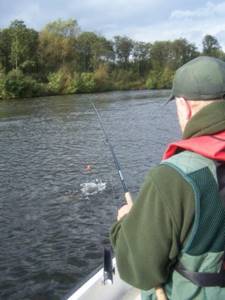
Initially, in order for pike fishing with live bait to be successful, you should provide yourself with the necessary bait. In our case - fry. As a rule, the size of live bait corresponds to the size of the future catch. But it doesn't always happen like this. There are often cases when a small specimen is caught using bait of considerable size. Perhaps the fish's hunger is affecting it.
In order not to waste time, it is necessary to learn in more detail about the habitats of this predator. Also in this case, the equipment for fishing with live bait must be suitable.
Let's say a river is chosen as a fishing spot. In this case, fishing with live bait from the shore is quite possible. Since pike hunts not far from this place. What is this connected with? The answer is very simple - the fry does not have the habit of swimming to depths. Here we must immediately note an important condition. It lies in the fact that constant casting and maintaining depth is quite tiring. Thus, this action turns into a grueling process. Therefore, fishing with live bait on a float will be the best option for fishing for pike. This option will contribute to proper rest. Don't cast your fishing rod too far. It is better to find thickets of reeds for potential casting.
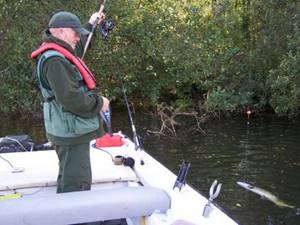
Malyavochnitsa manufacturing technology
Another specialized device for catching fry is the so-called small fish. To make it you will need the following materials:
- Mesh with a fine cell measuring 1 m2.
- Rope 7-10 mm thick and about 5 m long.
- Strong rope 2 m long.
- Two flexible wooden rods 1.5 m long.
- Stick 3 m long.
- Feed bag.
- A weight weighing 200-250 g.
These materials are used to make a mesh with the ends tied together with rope. A thin rope is passed around the perimeter of the canvas, after which two rods are fixed to the mesh through slots in the corners. In this position, the rods should be secured with ropes. Moreover, the sticks should form a bent cross-shaped structure. At the intersection, a fixing knot is also made with a rope, to which a strong cord is attached.
How to catch fry for live bait in the summer using a small fish? A thick stick is tied to the cord, with the help of which the entire structure will be pulled out after some time of accumulation of the catch. The net is first immersed in water with complementary food, which is in a tied bag. The weight, in turn, will pull the little fish to the bottom.
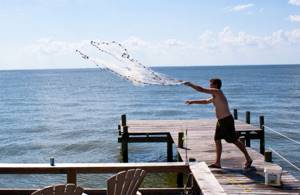
Proper storage of live bait
It is immediately necessary to separate two storage tactics - for a short period directly during the fishing process and for a long time in the off-season. Without special conditions, most live baits lose the desired condition within the first day after fishing. Among the simplest means of maintaining their life, we can recommend any container or even a summer cottage pond for temporary maintenance. At home, in jars or containers, for example, crucian carp can last up to two weeks. But how to preserve live bait in the summer, if we are talking about months? In such cases, you cannot do without special equipment. At a minimum, you will need the same containers with clean water and the ability to connect a compressor unit and filters. Essentially, you need to be prepared to organize the conditions of the aquarium to ensure a full, healthy life for the fish.
Features of storing fry
The most difficult situation from a storage point of view is with fry. The task is aggravated by the fact that, in addition to preserving life, they need a healthy habitat, otherwise there will be a risk of contracting infections. And long before storage, the characteristics of contacts with this animal should be taken into account. For example, how to catch fry for live bait so that they initially have a better chance of long-term storage? Firstly, fry should only be removed with a net or other devices - they often die from touching with hands. Secondly, in the very first hours after catching, they must be left in the refrigerator with aerated water. Moreover, even at the time of fishing, it would be nice to have a cooler bag with you, but without cooling elements.
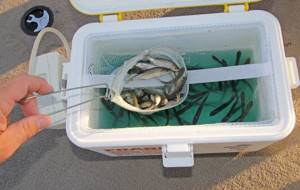
Live bait equipment
Even with properly prepared live bait, there is every chance of reducing the likelihood of successful fishing to zero with incorrectly selected gear. First you need to decide on the hooks, since small fish are extremely sensitive to this part. You can use single hooks, as well as doubles and tees.
Success lies in a competent assessment of the planting technique. For example, due to their light weight, bleak and top-finned fish are inserted through the nostrils, and given the deep swallowing of them by the predator, the use of several hooks is impractical. Doubles should be used in cases where it is planned to bait through the gills. That is, in the question of how to catch live bait in the summer, you should be careful with this part of the fish in advance, trying not to damage it.
As for the gear, it is quite possible to use the donka in the form of a stand. This is the simplest system of a fishing line with a sinker, which ends in one or more eyeliners. The float is added at will depending on the fishing conditions. There are also no special restrictions in terms of the use of fishing rods and spinning rods, but in each case the nuances of the behavior of live bait and the means of controlling it should be taken into account.

How to put live bait on a hook?
The fishing itself begins with placing the fish on the hook. If crucian carp is used, then the fish is carefully placed on the hook so that the bait is located parallel to the ground. It is advisable to slightly tilt your head down to ensure more comfortable swimming. To do this, the back is pierced a little closer to the tail, while trying not to damage the spine of the live bait.
In addition to this nozzle method, the following method is sometimes used. You need to take the fish and carefully insert the leash through the mouth into the gill cover, and only then fasten the hook. This will preserve the fish and allow it to swim longer and more actively. This bait is made if the angler uses a double hook, and roach is used as live bait.
